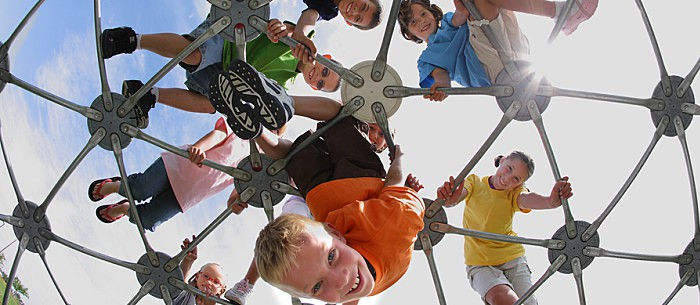Remember your carefree elementary-school days of playing with friends at recess, running around outside and just enjoying life? Did you favor jumping rope, or were you always looking for a good game of tag?
Take a walk down memory lane by teaching your kids these six playground games — an afternoon of playing outside will do you all good.
Why Active Play Is Important
Teaching your child how to play outdoors is just as important as giving her the time to play. “Nowadays, what you find is children are scheduled into so many classes like dance or karate, and it’s all with adult supervision. There isn’t time for kids to socially interact,” explains Dr. Melinda Bossenmeyer, founder of Peaceful Playgrounds. “During recess, they learn to be a leader, be a follower and to self-initiate play instead of an adult telling them what to do. Additionally, an emerging body of research indicates that children who have physical activity at recess are better able to focus when they get back in the classroom.”
Games don’t just help with social interaction. Playing outdoors also provides numerous health benefits. And that’s not all: J.J. Ferrer, author of “The Art of Stone Skipping and Other Fun Old-Time Games,” says, “Aside from providing exercise, fresh air, human contact and fun, active games teach us to strategize, solve problems, be creative, build self-esteem and improve motor skills.”
Here are 6 classic playground games every kid should know:
- HORSE
You need a basketball and a hoop. Player 1 takes a shot from anywhere using any method (one-handed, backwards). If she makes the shot, Player 2 attempts to replicate the exact shot. If he misses, he gets an “H” and Player 1 picks a new shot. If Player 2 makes the shot, he gets to call the new shot. The game continues until one player has missed enough shots to spell the word “horse.” This game can be modified to include more than two players by rotating who calls the shot if more than one person sinks it.
- Red Light, Green Light
One player is the caller and stands facing the other players. She calls out “Green light!” and the players run toward her. When she says “Red light!”, they stop. Any player who moves or takes another step after red light is called is out of the game. The last person standing wins and becomes the next caller.
- Helicopter
Players stand in a circle with one person in the middle as the “helicopter.” The helicopter holds onto one end of a jump rope and spins around, letting the rope drag on the ground. The players must jump over the rope as it passes them. Anyone who misses, lands on the rope or gets hit is out. The last player standing wins the game and becomes the next helicopter. The helicopter can keep the rope on the ground or raise it slightly, making it more difficult to jump over.
- Popcorn
Player 1 throws a basketball or rubber ball up in the air, claps once while counting out loud and catches the ball. He then repeats the action, increasing the number of times he claps before catching the ball by one each turn. If he misses the ball, drops it or fails to increase his clapping, his turn is over. Player 2 now tries to make it to a higher number than Player 1. Whoever gets the highest number wins. You can also play by bouncing the ball instead of throwing it.
- Red Rover
Divide into two equal teams, each forming a long line by holding hands. The lines stand facing each other, about 20 feet apart. Team A shouts, “Red Rover, Red Rover, send Sally right over!” Sally, from Team B, runs at Team A and tries to break through the line. If she succeeds, she returns to her team and takes one of the players from Team A with her to join Team B. If she fails, she must join Team A. Play continues, alternating which team sends runners, until one team has gained all the players.
- 500
One player throws a ball high up in the air and calls out a number. The other players attempt to catch the ball, and whoever catches it earns that many points. Play continues until one player reaches 500 points. He then becomes the thrower.
It’s most effective — and most fun — to teach while playing. Kids learn by doing, so explain the rules as you go. Demonstrate. Show them how to do a particular skill they’ve never tried before. Engage — if you want your kids to ditch the screen and play outside, lead by example and leave your phone inside. And play with them — you’re not too old to have fun!
NEED HELP? Find affordable summer nannies near you.
Victoria Georgoff is a freelance writer and psychotherapist who enjoys writing about parenting, helping other parents and, of course, being a parent herself. Follow her on Twitter @SheAlsoWrites.






